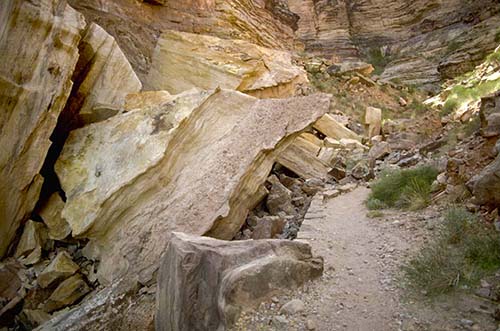Good spotting, however it means most likely that whoever wrote that article made a typo. They're quoted from a previous source, and probably just misquoted - it's easy to quote the same number twice. It's obvious the volume of water would always be larger than the volume of sediment. There's no point doing any maths on numbers that were simply a mistake.
Nope. Daniel's quoted source cited the stated and combined volume of the two supposed lakes.

Various sources cite the volume of the Grand Canyon as being 5,450,000,000,000 cubic yards which works out to about 1,000 cubic miles. Not three thousand yet the 3,000 cubic mile figure is cited repeatedly across the numerous sites that promote the hydroplate theory. Somehow this figure is important to the people promoting the theory even though it is utterly implausible.
It is still laughably implausible that only three units of water can completely scour and decompose one unit of solid rock.
It is further laughably implausible that these two imagined lakes could overcome and breach a physical barrier that is 120 to 277 miles thick.
What is missing from the physical evidence to support this theory that a catastrophic flood created the Grand Canyon are the physical traces commonly found in areas subjected to catastrophic flooding.
1. Erratics. These are the large boulders that are swept far downstream by massive floods. These erratics can be traced back to their approximate origins. No such erratics have ever been found downstream of the Grand Canyon. The size of erratics that are not borne by ice (as is seen in the Willamette Valley) is sometimes used to calculate the volume and force of the water needed to perform this act.
2. Scablands. There are no scablands downstream of the Grand Canyon as there are downstream of Lake Bonneville and Lake Missoula. Areas where sediments and soils were completely washed away by catastrophic floods.
3. Massive cataracts. These are places that demonstrate massive amounts of erosion such as is found in the Pacific Northwest. Massive amounts of water scoured out waterfalls shaped similarly to the waterfalls at Niagara, leaving behind significant evidence of their existence. There are no such cataracts either in or downstream of the Grand Canyon and proof of this is the fact that people raft the river every year without needing to portage around such cataracts.
There is more but these three things are sufficient to make the case that there was no evidence of catastrophic flooding downstream from the Grand Canyon on a greater scale than what is seen in the Columbia River Valley.
In modern times we can see the power of water and its limitations in catastrophic flooding events like dam failures:

Top 5 Biggest Dam Failures in the World
Dams play an extremely important role in flood control, power generation, water supply, and irrigation. However, they also pose significant threats to the downstream areas as a result of the water …
In every one of these failures you can still find evidence of their occurrence. Erratics in the form of large parts of the dams can still be found downstream, gravel and sediment deposits can still be found downstream that occur well away from the normal riverbeds.
But most notably the thing that is eminently observable as being absent is a drastic scouring of the land downstream. Even with a massive amount of water released there were still homes and other structures that survived the floods, roads survived, railroads survived, recognizable landmarks survived, and for the most part river channels were relatively unaffected as can be verified by comparing pre-flood maps with post-flood maps.
The absence of catastrophic flood evidence at the Grand Canyon (cataracts, scablands, erratics, etc.) indicates a gradual erosion of the canyon over time.
Wishing it to be otherwise does not make it so.




